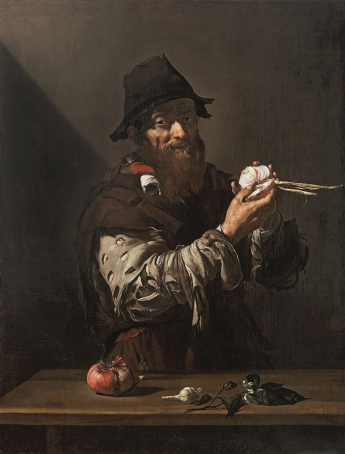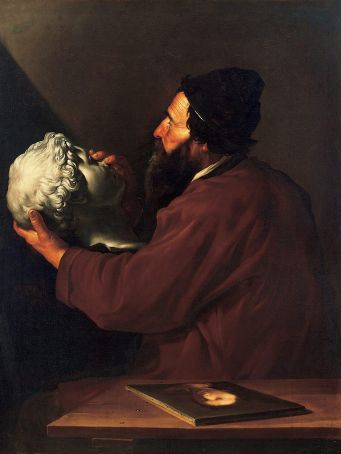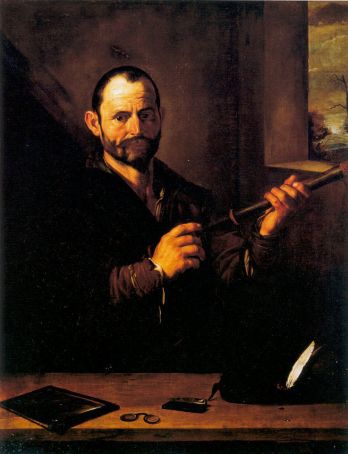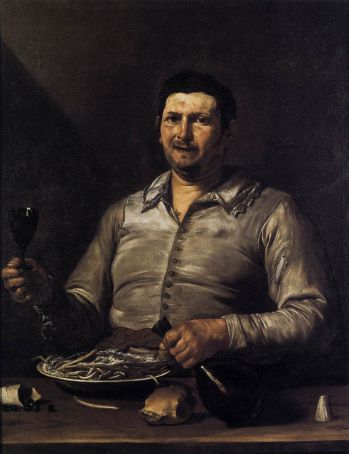Lo Spagnoletto: Jusepe de Ribera's Roman Stay in Four Senses
Ribera created the Five Senses series during his four years in Rome.
Three years after Caravaggio’s lonely death on a beach outside Porte Ercole, a Spaniard, still in his early twenties, arrived in Rome via Parma where his depiction of St Martin for the S. Prospero church had won him recommendation from another great Baroque master Guido Reni.
As apparent from the parish records, soon Jusepe de Ribera was lodged with his brothers in Via Margutta, then like now an artistic hub. His four-year stay (1612-1616) is attested to by the register of the Academy of S. Lucia, with which evidently, despite earning a princely five or six scudi a day, he had run up debts.
Perhaps seeking parallels with Caravaggio, biographer Giulio Mancini hints at riotous living, though this was to end with Ribera’s departure for Naples. “Lo Spagnoletto” came into contact with long-established Sicilian artist Bernardo Azzolino.
By way of a test, Azzolino asked Ribera to draw him a head. This Ribera did to such perfection that, as in a fairy tale, Azzolino made the young arrival an offer: “Everything you’ve seen shall be yours since, should you wish to marry my daughter, it’s to her that are destined all my earthly goods.”
So Jusepe took the then 16-year-old Caterina as his wife. Unlike Caravaggio, his existence from thereon was comparatively settled, one of his daughters even becoming his model. When offered work back in his native Spain, Ribera stayed put, by all accounts an exile by his own volition, eventually being laid to rest in Naples’ Margoglino district in 1652.
But to get back to his Roman stay. Thanks to the support of Caravaggio’s ex-patron Marquis Vincenzo Giustiani, Ribera would have had time to study the late genius’s work. To cite Palomini writing in 1724, “Ribera mastered Caravaggio’s chiaroscuro, making daily progress, with repeated imitation from nature.” Another link with Caravaggio would be the Baroque’s ‘Theatre of Cruelty’, an arena where Ribera might be even said to upstage his tormented, more famous mentor.
As Byron’s Don Juan describes some paintings in the poet’s family mansion: “Of martyrs awed, as Spagnoletto tainted/ His brush with all the blood of all the sainted.” He would depict the flaying of Saint Bartholomew times over. In a pagan context, there’s his Marsyas in Naples’ Capodimonte museum, Apollo presiding over the scene with a set of scalpels as the dentally-challenged satyr writhes towards the viewer in a feat of foreshortening.
Yet Ribera could produce work more beatific than violent. Such, for instance, is his radiant portrayal of Jacob’s dream. Nor in the paintings completed during Ribera’s Roman stay is there an instrument of harm or speck of blood in sight: the series of the Five Senses evokes a studied calm. (Hearing has been lost, the other four are dispersed in collections around the world).

Take Smell, here noun or verb, transitive and intransitive at the same time, pungently indicative. Ribera’s pauper is accompanied by a trio of vegetables, bringing together still-life and portraiture in a single frame. “Smells you could peel”, goes a saying. Cut onion prickling his nose still pointier, he luxuriates in odours’ warp and weft, a rustic elf, stench’s djinni, tavern satyr. Battered hat. Goat-tuft beard. Sleeves with circular tears like vents: all emit, in turn, a tang of their own.
Ribera depicts them as painstakingly as more conventional painters might a cardinal’s robes or arch-duke’s perfumed doublet. “I will astound Paris with an apple,” said Cézanne. Ribera manages an equivalent with two split onions and a head of garlic. A token sprig of bergamot gets overpowered. Sight sniffs. Nostrils blink.
From smells you can see to sights you can feel. Touch features a blind Michelangelo look-alike feeling a piece of ancient sculpture. Or rather “seeing” its lineaments on our behalf. His hands modelled with sculptural rigour confirm how lack of one sense can enhance another. What we take as a given, becomes to the sitter an act of devotion. His brow crinkles in concentration.
As in Dutch still-lifes, painting acquires a relative weight all of its own. In an exercise of synaesthesia, touch is exalted as a sort of inner eye. Meanwhile on the table in front, a portrait-painting laid flat suggests the link between the perfection of ancient sculpture with the Baroque’s newfound pictorial naturalism.

If Touch concerns itself with the close-at-hand, Sight extends the new naturalism to the heavens, painting and astronomy never so well aligned. In it a man holds the first telescope in western art. Fittingly it is inlaid with two gold bands. Here’s the device Galileo developed a few years before, raising the focus of the Dutchman Hans Lipperhey’s 1608 invention 20 times. Galileo, thanks to his adjustments, in 1609 sketched the phases of the moon with all its pocks and craters.
Then in 1613, after a spell of sky-gazing on S. Maria Maggiore’s roof, the artist Ludovico Cigoli, a friend of Galileo, dared to insert the revised distinctly imperfect view of the celestial body observed there into the fresco of Immaculate Conception in the basilica’s Pauline Chapel. The Virgin stands upon a sphere anything but smooth, while the sun behind her is marked by the spots Galileo first observed in 1610.
Re-fast-forward to Ribera’s portrait: the tense forehead and wide-eyed look of the central figure seem to reflect wonder at the new astronomical phenomena he too could have just shared in. Endowing Sight with further interest is the possibility that Ribera and Galileo had actually met; their dates in the city more or less coincide, as do the learned circles (c.f. the fore-mentioned Academy of S. Lucia) in which they moved.

Where the background in Ribera’s other three paintings is in shadow, Sight has a window. The crepuscular view it frames is vaguely reminiscent of Adam Elsheimer’s Flight into Egypt. The German artist’s 1609 night picture is less-land-than-skyscape. It was also revolutionary: following the findings set out in Galileo’s Siderius Nuncius, the Milky Way is depicted not as a cloud but a conglomeration of innumerable stars. As in Cigoli’s fresco the moon is cratered.
Then the constellations are clearly visible: Ursa Major and Leo, with the star of Regulus shedding thematic light on the Biblical scenes below. (Regulus for new-born king; the Milky Way for stairway to heaven.) Florian Heine in his The First Time: Innovations in Art pinpoints a date: Elsheimer reproduces the sky over Rome as it was on 19 June 1609. This with an accuracy made possible by the instrument similar to that clasped gingerly by Ribera’s moon-struck sitter.
On the one hand, lo Spagnoletto’s portrait pays tribute to Galileo. Less directly, via that window’s picture within a picture, might it also cross-reference Elsheimer, active in Rome until his early death in 1610, just years previously? Speculation, yet in the small (and international) world of Rome’s Baroque, not unfeasible.
A short walk from Via Margutta, the German painter is buried in S. Lorenzo in Lucina. Rubens praises him in a letter. Was Ribera, however tangentially, doing the same in paint? Back down to earth with Taste, the last surviving painting of the series. Picture any osteria, past or present: there sits a figure, his silvery jerkin tarnished by spillage, matching chromatically the plate of anchovies on the table in front.

Grub before art, he glares between mouthfuls, threatening to burst a button. Or convert his clenched quarto of wine into a missile. Like a seasoned skipper mid-tempest, the Spaniard’s equal to the worst human weather can throw. He doesn’t only take the goad on board. Putting his art first, he relishes it.
Some trace Ribera’s trencherman back to the inn-keeper in Caravaggio’s Misericordia in Naples, Ribera having already made a foray into the southern capital. Why should he have needed to go so far? The electrical tension depicted is surely first-hand.
Then there’s the medical element, one commentator diagnosing in the diner’s ruddy nose and cheeks and the swollen forefinger the symptoms of gout. Portrait as health warning, enduringly topical, realism from Urbs Eterna. A pity that, due to Ribera’s Spanish connections, the four works discussed have ended up in the New World, far from Rome and hence rather overlooked.
“One more caravaggista” lo Spagnoletto is often labelled; it’s time for an upward re-assessment.
By Martin Bennett
This article was published in the January 2023 online edition of Wanted in Rome magazine.

















